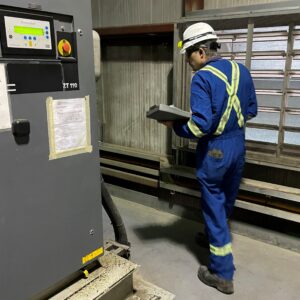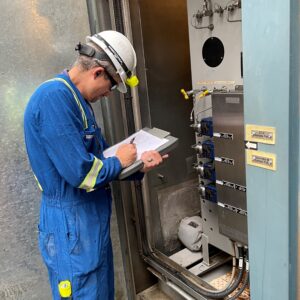The goal of preventive or predictive maintenance is to reduce the probability of failure, or mitigate the consequences of failure of an asset or group of assets, or both. By understanding the risk of an asset’s downtime against production, safety, the environment, and a company’s reputation, maintenance professionals can develop an optimized plan to maintain their equipment.
Our reliability solutions are designed with your individual needs in mind. We’ll help you identify inefficiencies in your current oil analysis programs and lubrication processes, devise and implement plans for improvement and provide sustainable solutions to put you in control.
Reliability Projects
Fluid Life has the tools and the expertise to assist you on the journey to optimized maintenance. If your goal is improved reliability and availability, partner with Fluid Life’s Reliability Team to benchmark your current maintenance practices against industry leaders and develop a plan to close the gap. Together, we will have an impact on your business, and demonstrate measured success.
WHATEVER YOUR CHALLENGE,
WE HAVE A SOLUTION THAT’S RIGHT FOR YOU
Benchmarking & Audits
Fluid Life leverages our team of reliability experts to identify and document gaps within your lubrication process. This benchmarking exercise allows us to generate a prioritized action plan to address shortcomings and implement industry best practices.
AREAS OF FOCUS:
- Lubricant standards, consolidation and procurement
- Lubrication program objectives and indicators
- Lubrication and re-lubrication practices
- Lubrication program management
- Leakage control and safe lubricant handling practices
- Storage and handling
- Contamination control
- Oil sampling techniques
- Oil analysis
- Continuous improvement
- Training and certification
- Procedures and guidelines
WHAT’S INVOLVED:
Step 1: Identification – The process includes staff interviews, review of mechanical assets and discussion of compliance to maintenance practices and procedures.
Step 2: Documentation – Offsite report generation including recommendations and a prioritized action plan. Scorecard findings are also uploaded into myLab.
Step 3: Solution – Presentation of the final report to key stakeholders.
For more information on Scorecards, contact a Fluid Life representative.
A successful oil analysis program starts off with a strong foundation. A Fluid Life Reliability Specialist will conduct a thorough onsite inspection of your lubrication program, equipment to be tested and operating conditions. You will receive a comprehensive road-map document along with a turnkey process to get you started on the right track.
FEATURES:
- Identification and documentation of gaps in your lubrication processes
- Identification of equipment to be included in the testing program
- Proper sample points, recommended fittings and sampling procedures
- Recommended test slates & sampling intervals
- Prioritized action plan for improving lubrication and oil analysis processes
WHAT’S INVOLVED:
We will assess your overall lubrication processes, identify organizational-level gaps, and build a framework for the oil analysis program. Assets will be evaluated on the basis of criticality, operational usage, fluid environment, size of reservoir and safety considerations. We will establish proper sample point locations, sampling procedures, test slates, sampling frequencies and data interpretation guidelines for each asset. Fluid Life will populate myLab with the asset list, testing defaults, sample scheduling information as well as provide a formal report with improvement recommendations.
For more information on Sample Point Audits, contact a Fluid Life representative.


An optimal greasing program starts off with a strong foundation. A Fluid Life Reliability Specialist will conduct a thorough onsite inspection of your greased assets including a review and documentation of the type of assets and operating conditions. You will receive a detailed report outlining a recommended greasing process for your assets.
FEATURES:
- Identification and documentation all greased assets.
- Identification of equipment to be included in the greasing program.
- Recommended grease intervals and amounts.
- Recommended grease delivery methods.
WHAT’S INVOLVED:
We will assess your overall greasing program, identify organizational-level gaps, and build a framework for the greasing program. Assets will be evaluated on the basis of criticality, operational usage, environment, size of equipment and safety considerations. We will establish proper greasing frequencies and amounts, for each asset. Fluid Life will populate myLab with the asset list with tasks for greasing including frequencies and amounts.
For more information on Equipment Grease Audits, contact a Fluid Life representative.
Optimization & Improvement
It takes real discipline to schedule, execute and close out your maintenance or lubrication tasks on time. Fluid Life offers a concrete solution. myLab™ is an application tool that effectively and conveniently manages your daily maintenance and lubrication tasks. Using our myLab™ portal, Fluid Life’s Reliability team can provide you with our Lubrication Route turn-key solution.
LUBRICATION ROUTE TURN-KEY SOLUTION:
- Populate asset list, equipment tasks, PM tasks, work orders and routes into myLab™
- Review KPI metrics
- Provide role-specific training on myLab™ Identification and documentation of gaps in your lubrication processes
WHAT’S INVOLVED:
Step 1: All relevant information for maintenance and lubrication task scheduling will be gathered. Sources may include an oil analysis audit, lubrication survey or information directly captured from your site. Fluid Life will upload this data into myLab™.
Step 2: Fluid Life will confirm with you the configuration of specific routes and tasks in myLab™.
Step 3: Fluid Life will provide you with role-specific training on tasks, routes, work orders and dashboards within myLab™.
For more information on Lubrication Route Task Management, contact a Fluid Life representative.
Worried about your oil analysis program not catching failures at an early stage? Overwhelmed by the large number of alarm conditions? Fluid Life offers a systematic approach for optimizing the flagging thresholds used on your oil samples. This service allows you to validate the relevance of current flagging limits and modify them as desired. Your two main benefits: better reliability focus and data noise reduction. Flagging Optimization may improve your site’s flagging limits while increasing the ROI of your oil analysis program.
FEATURES:
- Analysis of your oil analysis histories and calculation of proposed flagging limits
- Review of proposed flagging limits against current global flagging limits to find key changes
- Identification of flagging limits to be tightened to ensure that problems are not being missed
- Investigation of flagging limits to be loosened to ensure that problems are not being ignored
- Summary report provided to you for review
- Fluid Life’s reliability specialist will build consensus with your site over the most appropriate
flagging limits - New flagging limits are captured in Fluid Life’s laboratory system and applied to all of your
samples going forward
WHAT IS INVOLVED?
Fluid Life Reliability Specialists use an interpretive process for optimizing flagging rules. They will examine the most significant problem areas within your operation and validate them against machinery conditions. Key findings will be reviewed to gain consensus of how to respond effectively to your problem issues. Any modifications to the flagging rules will be uploaded into Fluid Life’s laboratory database and a final report will be issued as reference material. For more details, read our Flagging Limits FAQ’s.
For more information on Flagging Optimization, contact a Fluid Life representative.
Does your company have the goal of developing and implementing a world-class lubrication program? Fluid Life can help you establish lubrication standards and identify the policies and procedures that will minimize breakdowns, improve operating performance and produce a safe and profitable operation.
Elements Reviewed
- Lubricant policy and standards
- Training standards and procedures
- Lubricant storage standards and procedures
- Lubricant handling and dispensing practices
- Lubricant selection standards and criteria
- New lubrication delivery inspection and acceptance standards
- Fluid cleanliness and contamination standards
- Standards and procedures for routine lubrication checks and inspections
- Oil drain interval and criteria
- Oil analysis criteria and sampling standards
- Tank breathers and contamination exclusion devices
- Waste oil collection and disposal standards and procedures
A Fluid Life Reliability Specialist will review your current lubrication workflows and practices with you, and discuss improvements and modifications that could be implemented. A formal lubrication standards document is then created in order to communicate lubrication policies and standard operating procedures to the entire organization.
To learn more about these additional lubrication projects, contact a Fluid Life representative.
Advanced Analysis
A site’s criticality analysis should be a living document. As new assets are commissioned and other assets age, the risk profile for the owner operator will change. Fluid Life partners with our clients to deliver an independent, third party prospective on the risk associated with an asset (or group of assets). Our Reliability Specialists assist customers in identifying the most critical assets to a site or process using a risk-based model that incorporates the potential impact on people, production, environment and reputation. Total risk, once assessed, is used to drive asset maintenance strategy.
Preventive Maintenance Optimization or PMO is a process that challenges your maintenance activities against an asset or group of assets. By matching restoration tasks to specific failure modes for equipment, PM tasks are reconsidered based on how they have failed or are anticipated to fail. This predictive approach ensures maintenance departments aren’t spending resources doing maintenance too frequently, or not frequently enough.
The PMO process weighs the customer’s risk tolerance with recommendation from the OEM, the asset’s PM history, the asset’s failure history, and the performance required of the asset. An optimized PM plan is delivered based on this analysis that ensures the right maintenance tasks are performed at the right interval to ensure availability of the asset while minimizing the maintenance effort to achieve the required level of performance.
This exercise is similar to a Reliability Centered Maintenance evaluation, but on a much simpler scale. A reliability engineer can facilitate PMO with the assistance of personnel responsible for maintaining the asset.
If your equipment is not running as desired or is failing unexpectedly, then the assumptions that created the PM schedule need to be revisited to prevent future failures. This process will help you achieve that.
Process
- Determine equipment candidates for PMO process
- Gather all current and past PM plans to maintain equipment, including feedback and as found conditions if available
- Observe PM task execution if possible
- List all spare parts required for current PM tasks
- Review the efficiency of current maintenance practices around the PM tasks
- Review the efficacy of PM tasks against each failure mode for the studied equipment
- Consider order of execution to allow for the greatest efficiency of execution of PM plan for an asset or group of assets
- Provide recommendations for an optimized PM task grouping and order of execution
Deliverables
- Optimized PM plan for maintaining studied equipment
- Upload new plan into CMMS
- Recommended maintenance procedure changes (spare parts, tooling, and work logistics)
Equipment failures are unfortunate but they can teach valuable lessons going forward. A Fluid Life Reliability Specialist can conduct a post-mortem review of oil analysis results in order to suggest key adjustments to the testing program that will reduce the incidence of future catastrophic failures.
Features:
- Summarize details of failure
- Observations of oil analysis findings
- Background research
- Conclusions
- Recommendations for improvement
- Failure findings are uploaded to myLab
What is involved?
A Fluid Life Reliability Specialist will meet with you to gather relevant details of the failure, including tear-down inspection findings, operational and condition-monitoring data and work histories.
A report is generated that summarizes the oil analysis history and the corrective actions that were taken in response to any early warning signs of failure. Recommendations are made to improve oil analysis effectiveness in its goal of reducing failure occurrences.
These recommendations include possible modifications of sampling methods, testing frequencies, test slates, alarm points, triggered testing options and corrective action plans.
Failure Mode and Effects Analysis is a step-by-step approach for identifying the ways an asset or process can fail. The process utilizes a cross-functional team with knowledge about the process, asset or service. Once the team is assembled, the scope for the FMEA must be defined, the team must address the following questions for each asset or process under consideration:
- What are the functions of the asset (in line with the scope)
- How can each function fail to meet a required standard of performance?
- What scenarios can lead to those failures?
- What are the consequences of those failures?
- How serious are those consequences?
- How often will they occur?
- Can they be predicted?
- What is the associated risk with those failures?
Fluid Life will facilitate and contribute to the RCA process. Root Cause Analysis is an approach for identifying the underlying (“root”) cause(s) of an incident such as equipment failure after it has occurred. Usually employed when something goes wrong, it can also be used to identify what led to something going right so it may be duplicated in the future. Fluid Life’s Reliability Specialists are trained to employ different techniques to assist our customers in determining what the problem was and why it happened, determined by the loss potential of the incident.
Three service levels (Minor, Moderate & Severe) are available depending on the nature of the incident and the customers desired output. Fluid Life’s Reliability Sales Specialists work with customers to help determine which service level is right for them.
Process
- Determine the loss potential – calibrate the RCA effort and process to the incident
- Consult the corporate risk matrix to validate the recommended effort
- Secure the scene (if appropriate) and gather initial data (pictures, statements, parts)
- Select the team of personnel to conduct the investigation
- Choose the right RCA tool to conduct the analysis
- Gather evidence (inspection results, maintenance histories, personnel interviews)
- Complete the study
- Compile the results and summarize the findings
- Present findings to relevant parties to prevent the incident from re-occurring
Deliverables
- Report of corrective actions with clear actions, owners, and due dates
- Failure timeline and RCA methodology output
- Summarized learnings in an incident report that can be shared (if appropriate) that describes the impact of the failure to production, people, environment, reputation, or other criteria that are relevant to the customer
Experience the difference.
Contact us today and find out what we can do for you.
